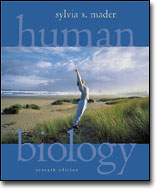 |
1 |  | 
Epithelial tissue absorbs molecules from kidney tubules because of fine cellular extensions called ______ . (p. 62) |
|  | A) | cilia |
|  | B) | microvilli |
|  | C) | flagella |
|  | D) | pseudopods |
 |
 |
2 |  | 
Glands that secrete their product into ducts are called ______ glands. (p. 62) |
|  | A) | endocrine |
|  | B) | exocrine |
|  | C) | isocrine |
|  | D) | leaky |
 |
 |
3 |  | 
Junctions that hold cells of the bladder together as it stretches are called ____ junctions. (p. 64) |
|  | A) | adhesion |
|  | B) | tight |
|  | C) | gap |
|  | D) | functional |
 |
 |
4 |  | 
Connective tissue ______ . (p. 64) |
|  | A) | provides support |
|  | B) | stores fat |
|  | C) | forms blood cells |
|  | D) | All of these are correct. |
 |
 |
5 |  | 
Connective tissue cells are separated widely by ______ . (p. 64) |
|  | A) | insulation |
|  | B) | a matrix |
|  | C) | fluid |
|  | D) | collagen |
 |
 |
6 |  | 
The protein collagen provides ______ to connective tissues. (p. 64) |
|  | A) | flexibility |
|  | B) | strength |
|  | C) | flexibility and strength |
 |
 |
7 |  | 
The fibroblasts in adipose tissue enlarge and store ______ . (p. 64) |
|  | A) | protein |
|  | B) | starch |
|  | C) | fat |
|  | D) | sugar |
 |
 |
8 |  | 
In cartilage, the cells lie in small chambers called ______. (p. 64) |
|  | A) | mountings |
|  | B) | lamellae |
|  | C) | adipose |
|  | D) | lacunae |
 |
 |
9 |  | 
Which cartilage is found in the pads between the vertebrae? (p. 65) |
|  | A) | hyaline |
|  | B) | elastic |
|  | C) | fibrocartilage |
 |
 |
10 |  | 
The most rigid connective tissue is called ____. (p. 65) |
|  | A) | muscle |
|  | B) | bone |
|  | C) | fibrocartilage |
|  | D) | hyaline cartilage |
 |
 |
11 |  | 
In compact bone, bone cells are located in lacunae that are arranged in concentric circles around tiny cylinders called ______ . (p. 65) |
|  | A) | osteocyte |
|  | B) | canal |
|  | C) | osteons |
|  | D) | matrix |
 |
 |
12 |  | 
Which components of blood are fragments of giant cells? (p. 66) |
|  | A) | platelets |
|  | B) | red blood cells |
|  | C) | white blood cells |
 |
 |
13 |  | 
Which connective tissue matrix is not made by the cells? (p. 66) |
|  | A) | bone |
|  | B) | blood |
|  | C) | cartilage |
|  | D) | bone, blood, and cartilage |
 |
 |
14 |  | 
Skeletal muscle fibers are ______ . (p. 67) |
|  | A) | smooth |
|  | B) | striated |
|  | C) | spindle-shaped |
|  | D) | fragmented |
 |
 |
15 |  | 
Where is smooth muscle found? (p. 67) |
|  | A) | intestines |
|  | B) | stomach |
|  | C) | blood vessels |
|  | D) | intestines, stomach, and blood vessels |
 |
 |
16 |  | 
The brain and spinal cord contain conducting cells called ______ . (p. 68) |
|  | A) | codons |
|  | B) | neurons |
|  | C) | axons |
|  | D) | leukocytes |
 |
 |
17 |  | 
Neuroglial cells ______ . (p. 68) |
|  | A) | support neurons |
|  | B) | protect neurons |
|  | C) | provide nutrients to neurons |
|  | D) | support, protect, and provide nutrients to neurons |
 |
 |
18 |  | 
Freely moving joint cavities are lined with _____ membranes. (p. 69) |
|  | A) | synovial |
|  | B) | serous |
|  | C) | pleural |
|  | D) | mucous |
 |
 |
19 |  | 
The _____ system transports nutrients and oxygen to cells and removes their waste. (p. 70) |
|  | A) | digestive |
|  | B) | circulatory |
|  | C) | excretory |
|  | D) | respiratory |
 |
 |
20 |  | 
The skin covers the body, protecting the underlying parts from ______ . (p. 62) |
|  | A) | physical trauma |
|  | B) | microbial invasion |
|  | C) | water loss |
|  | D) | physical trauma, microbial invasion, and water loss |
 |
 |
21 |  | 
The ______ layer lies below the dermis of the skin. (p. 73) |
|  | A) | epidermis |
|  | B) | gastrodermis |
|  | C) | subcutaneous |
|  | D) | supracutaneous |
 |
 |
22 |  | 
Which of these is an example of homeostasis? (p. 76) |
|  | A) | The pressure of blood |
|  | B) | The pH of the blood |
|  | C) | The concentration of glucose in the blood |
|  | D) | The body temperature |
|  | E) | All of these are examples of homeostasis |
 |



 2002 McGraw-Hill Higher Education
2002 McGraw-Hill Higher Education